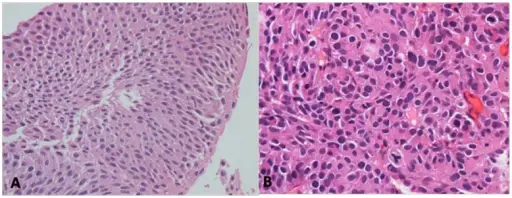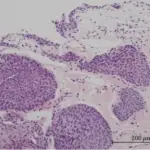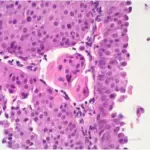Papillary urothelial neoplasm of low malignant potential is an exophytic (outward growing), (microscopically) nipple-shaped (or papillary) pre-malignant growth of the lining of the upper genitourinary tract (the urothelium), which includes the renal pelvis, ureters, urinary bladder, and part of the urethra.
What is the Pathology of Papillary Urothelial Neoplasm of Low Malignant Potential?
The pathology of Papillary urothelial neoplasm of low malignant potential is:
-Etiology: The cause of Papillary urothelial neoplasm of low malignant potential is unknown.
-Genes involved: No specific genes are involved.
-Pathogenesis: The sequence of events that lead to Papillary urothelial neoplasm of low malignant potential is an increased cellular proliferation that exceeds the thickness of normal urothelium and appears to lack the capacity to invade or metastasize.
-Morphology: The morphology associated with papillary urothelial neoplasm of low malignant potential shows 1-2 cm regular polypoid tumors.
-Histology: The histology associated with papillary urothelial neoplasm of low malignant potential shows an orderly arrangement of cells within papillae with minimal architectural abnormalities and minimal nuclear atypia, regardless of cell thickness.
How does Papillary Urothelial Neoplasm of Low Malignant Potential Present?
Patients with papillary urothelial neoplasm of low malignant potential typically affect males at 65 years of age. The symptoms, features, and clinical findings associated with papillary urothelial neoplasm of low malignant potential shows microscopic hematuria.
How is Papillary Urothelial Neoplasm of Low Malignant Potential Diagnosed?
Papillary urothelial neoplasm of low malignant potential is diagnosed by cystoscopy.
How is Papillary Urothelial Neoplasm of Low Malignant Potential Treated?
Papillary urothelial neoplasm of low malignant potential is treated like non-invasive low-grade papillary urothelial carcinomas, excision, and regular follow-up cystoscopies.
What is the Prognosis of Papillary Urothelial Neoplasm of Low Malignant Potential?
The prognosis of papillary urothelial neoplasm of low malignant potential is fair with 10 percent survival rates.



